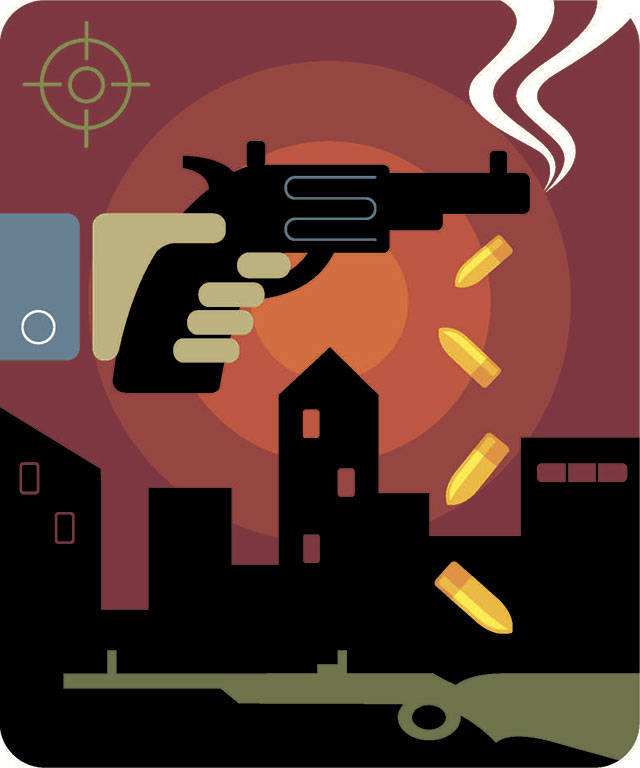By Public Health – Seattle & King County
Our public health approach to gun violence is a framework that works to understand how and when firearms are used unsafely, raise public awareness of firearm safety practices, and develop and evaluate upstream, evidence-based prevention programs in partnership with community stakeholders. This work hinges on effective data collection and analysis so that we can accurately assess community need.
Review our injury prevention team’s latest data release on firearm deaths in Seattle and King County, and you’ll find our most recent analysis of firearm deaths (both homicides and suicides). It looks at the data by geography, demographics, and over time in great detail, and we hope that this will help community and Public Health as they work to prevent gun violence.
A graphic in the link (and below) shows that among King County cities and neighborhoods, firearm homicide rates were highest in 2012-2016 for residents of North Highline, Burien and Kent. North Highline had a firearm homicide rate of 6.1 per 100,000 residents, Burien a rate of 4.5 and Kent a rate of 3.2.
The firearm homicide rate was highest among residents of King County’s south region with a rate of 2.7 per 100,000 residents. Seattle had a rate of 2.0 per 100,000.
In terms of homicide by firearm, the major takeaway is this:
From 2012-2016, the highest rates of death by firearm homicide occurred among young adults 18 to 24, men, and residents of high-poverty neighborhoods. Black residents of King County and Seattle were significantly more likely to be victims of firearm homicide than white residents – and the gap in rates between black residents and their white counterparts has increased over time.
It’s a narrative we’ve heard before, locally and nationally. But the data don’t tell the whole story – in addition to the individual lives lost, gun violence perpetuates trauma that can affect the community as a whole.
The Prevention Institute’s report Adverse Community Experiences and Resilience poignantly describes the ways structural violence and exposure to trauma can harm communities by breaking down social networks and relationships, interfering with basic needs, and damaging individual and community resilience. They present a framework for understanding, addressing and preventing community trauma that is being used in programs in King County.
Listening to community voices
Our data release roughly coincided with the anniversary of March for Our Lives, the nationwide youth-led march asking for changes to reduce the wave of gun violence affecting mainly youth and young adults. We asked them for their perspective on our data, and Shorewood High student Nara Kim, one of the youth leaders of March for Our Lives, responded:
“As the youth of the 21st century, we are the generation that grew up with mass shooting after mass shooting but it is imperative that we acknowledge and combat the gun violence our community faces on a daily basis. We must also acknowledge the systematic racism that has created a society in which gun violence disproportionately affects communities of color. We must uplift the voices of those who have been touched by this public health issue in order to enact policies and programs that will help protect King County and its residents.”
King County believes in a public health approach to gun violence prevention, and this includes working on solutions with the people most affected. This year, we’ll be collaborating with youth and young adults affected by gun violence, their families, and service providers who work with them to create recommendations for reducing firearm violence in King County. These recommendations will be compiled in a report and presented to King County Council and other community stakeholders.
Interrupting the cycle of youth incarceration
We’re also looking further upstream for solutions. We know that it’s not just the initial act of violence that can cause community trauma. Often, our criminal justice system perpetuates the cycle of trauma and systemic racial disparities that we see reflected in the gun violence report.
Our Public Health-led Zero Youth Detention initiative is working to interrupt the cycle of violence and institutionalized racism associated with the justice system by taking a trauma-informed approach to the juvenile legal system. This includes connecting victims and perpetrators to supportive services and expanding the use of restorative justice approaches for youth, an approach which has been shown to reduce recidivism and produce greater satisfaction for crime victims. To learn more, read about the first King County juvenile felony case tried with restorative justice.
• Editorial note from Public Health – Seattle & King County: This is a two-part series dedicated to explaining a recent data release about firearm deaths in King County and Seattle. In our next post we will focus on the latest data on firearm suicide.
Talk to us
Please share your story tips by emailing editor@kentreporter.com.
To share your opinion for publication, submit a letter through our website https://www.kentreporter.com/submit-letter/. Include your name, address and daytime phone number. (We’ll only publish your name and hometown.) Please keep letters to 300 words or less.

